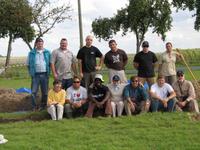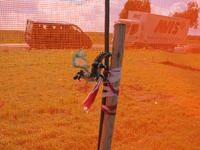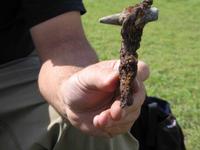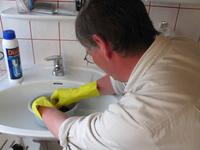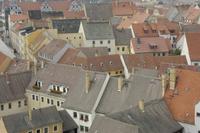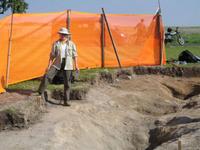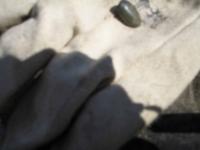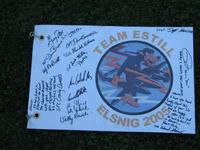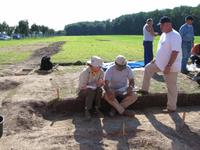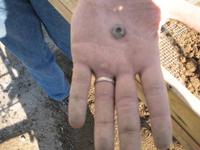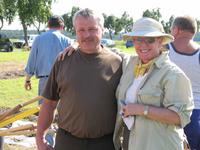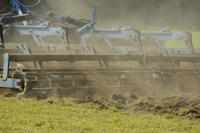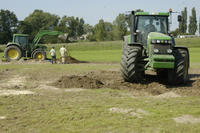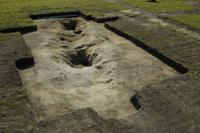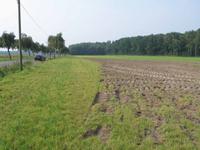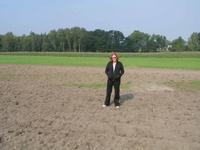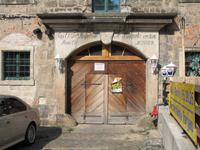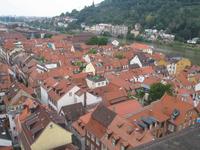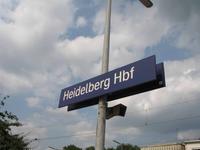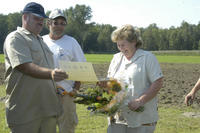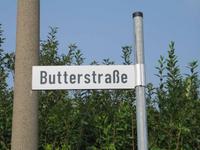26 August, 2005: With the presence of Hans-Guenter Ploes comes the orderly organization and placement of the found parts. This morning enough parts to recognize the bulk of two engines was arranged neatly at the edge of the crater. A cowling piece from the outside left of the plane was scraped and prodded from the dirt later in the morning. HG showed me a diagram of the cowling from his P-38 parts catalogue and compared the diagram to the found piece. They are an abstract match to my untrained eye but he is the God of Parts and who am I to disagree? A picture will be included in the next post depending upon the kindness of the guy who allows me to connect to his computer. The same guy, Ulf, has promised to put ALL the photos taken by anyone he knows who has visited the site on one big DVD so I will have them. I will spare you the full complement of pictures or slide shows except by special request.
The part of the crater that contained most of these engine parts is nearly exhausted and the next move will be in the presumed direction of the cockpit. I overheard Dr. Fox tell a reporter today that he expects to wrap this up in five to seven days! As I understand things, once the cockpit area is defined and excavated, there should be enough of what JPAC needs to consider this a successful mission. The focus remains on finding my father and his personal effects.
Even though that’s the obvious goal, I love the little pieces that are possible to identify and if not by anyone else, HG knows what they are and then they are even more cool and amazing. There are these little aqua corroded pieces attached to delicate wiring that was used throughout the complicated electrical system of the P-38 that survived still braided together. I also watch for the black bakelite pieces that were the front of his instrument panel and I am a complete sucker for switches and dials. We found one today that very clearly reads: A U D I O. See what I mean about wunderbar?
Doc Fox decided to abandoned the screening this afternoon in favor of filling in the trenches that would not be used. Everyone shoveled the dirt off the blue tarp into the nearest trench. The sky was an astonishing clear blue with massive white clouds and the sun was brilliant but it was cool. Can’t beat that for a collaborative moment in time. Fortunately, all the shovels were in use, so I took pictures and looked at the parts in the screens. At the end of the trench refilling, everyone gathered IN a trench for a group photo. They invided me to join them and then included the helpful and well-versed Germans (Wally, Hans Guenther, Ernst) These, too, will be uploaded for your viewing pleasure.
After the photo op, I noticed Herr Bormann the formerly unhappy farmer who owns the field, walking onto the site. I notified Ernst and Capt. Emmons that we had an esteemed visitor. We all held our collective breath for a minute. I had invited him to come to the field after our meeting on Saturday but he said then that he didn’t expect to have time. Apparently, he finds our work interesting (I thought “hmmm, bygones”) and he stood with me while our picture was taken. He has also invited any of the hunters in the group to join him for an early morning or evening hunting expedition for the boars that are runining his sunflower crop. That won’t be moi, but if it saves the excavation, gimme a gun. I still vote for love vs. war.
In between the engine unearthing and the trench filling detail, Dr. Fox and photographer, Linda Miller mapped a 3-D diagram of the site. Lots of careful measuring with string hung with a tiny level. Measuring, moving the string, saying numbers, shifting the level and voila! a diagram that I also photographed but cannot post because it is part of the official report. Sorry.
Have you all gotten the idea that I am enjoying this despite the fact that it is a mission of great love and deep feelings? I expect that the cockpit excavation and what emerges from there may up the emotional ante just a bit. I notice that I spend most of my time now sitting at the edge of the crater just watching the laborious scraping and smoothing. I am drawn to the heart of the crash site for obvious reasons. I feel as though I am in attendance to my father’s honor and his essence. I am his escort back to us if only in spirit and tiny earthly remains. Nonetheless important than it would have been if the team sent in the 1940’s to find him had succeeded. The only difference would have been the Estill present at the site. Knowing my grandfather as I did, he would have found a way to be here. I am just doing my daughter-thing which is one of the only direct things I can do for my father and nothing compared to what he has done for me.
By the way, this is the best way to get into shape. We can call it the trench digging, part sorting, and dirt hauling diet. Too bad the Germans are so good at bread and beer. Til next time, probably tomorrow.



